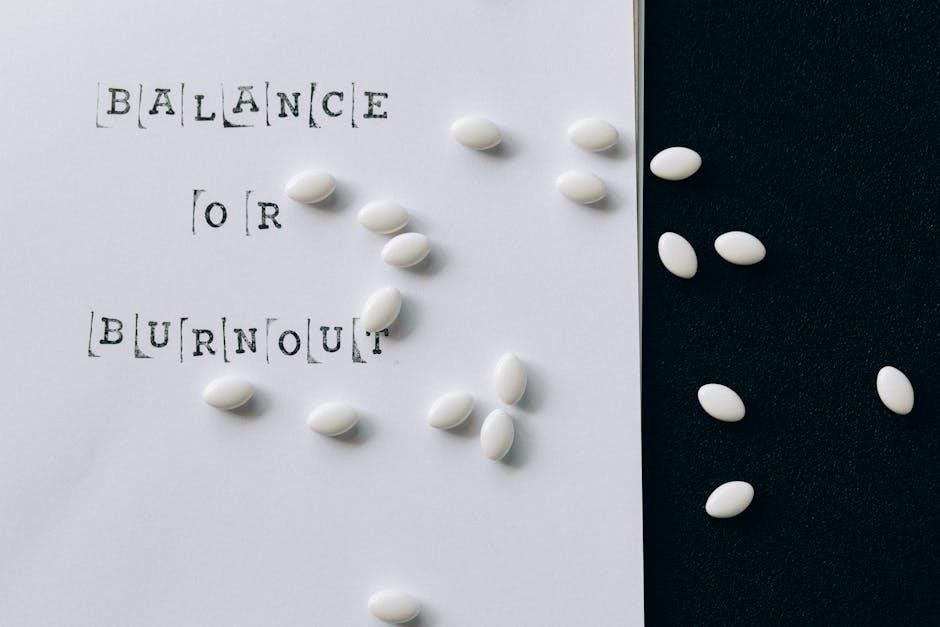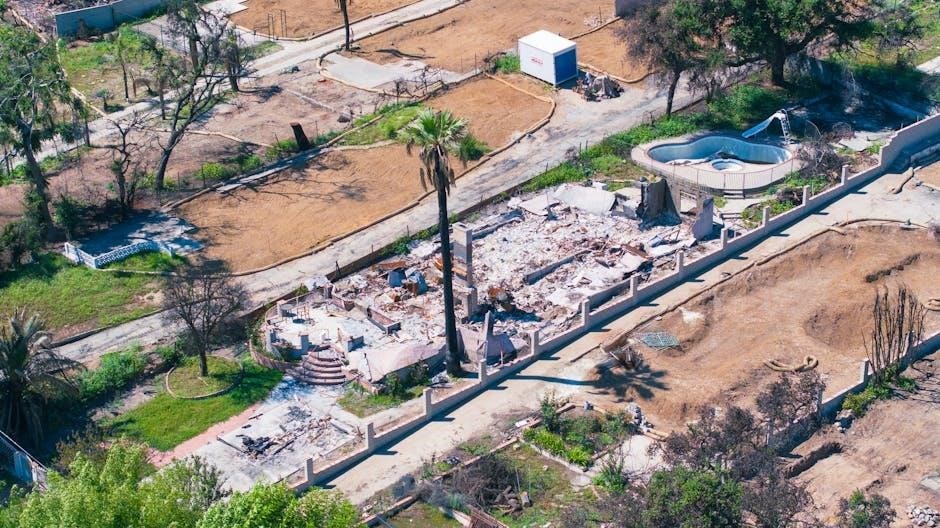A burnout recovery plan PDF offers a comprehensive, actionable guide to overcoming burnout. It includes strategies for self-care, boundary-setting, and seeking support to restore well-being and productivity.
Understanding Burnout and Its Impact
Burnout is a state of emotional, mental, and physical exhaustion caused by prolonged stress. It impacts productivity, relationships, and overall well-being. Recognizing its signs, such as chronic fatigue and detachment, is crucial for early intervention. A burnout recovery plan PDF provides tools to address these effects, helping individuals regain balance and prevent long-term mental health struggles.
Why a Structured Recovery Plan is Essential
A structured recovery plan is vital for addressing burnout effectively. It offers a clear roadmap, helping individuals identify root causes and implement actionable strategies. By setting boundaries, prioritizing self-care, and seeking support, a plan ensures steady progress and sustained well-being, preventing burnout from recurring and fostering long-term resilience.

Recognizing the Signs and Symptoms of Burnout
Recognizing the signs and symptoms of burnout is crucial for early intervention. Physical, emotional, and behavioral indicators signal the need for immediate action to prevent further deterioration.
Physical Symptoms: Fatigue, Headaches, and Insomnia
Physical symptoms of burnout include persistent fatigue, frequent headaches, and insomnia. These bodily signs reflect prolonged stress and emotional exhaustion. Addressing these symptoms early is essential to prevent further health complications and support recovery. Incorporating rest, hydration, and balanced nutrition can help alleviate these physical manifestations of burnout, as outlined in a comprehensive recovery plan.
Mental and Emotional Symptoms: Exhaustion and Detachment
Mental and emotional burnout symptoms include profound exhaustion, emotional detachment, and a sense of hopelessness. These feelings often stem from chronic stress and overwhelm. Recognizing these signs early is crucial for recovery, as they can significantly impact daily functioning and relationships. A structured recovery plan can help address these symptoms through emotional healing and stress management techniques.
Behavioral Indicators: Reduced Productivity and Pessimism
Behavioral signs of burnout include reduced productivity, procrastination, and a pervasive sense of pessimism. Individuals may struggle to complete tasks, exhibit cynicism, and withdraw from responsibilities. These indicators often reflect underlying emotional exhaustion and detachment; Addressing these behaviors early is critical to preventing further decline and fostering recovery through structured strategies and support systems.

The Burnout Recovery Process
The burnout recovery process involves a structured approach to healing, combining rest, reflection, and rebuilding support systems to restore mental and physical well-being.
Setting Boundaries: Learning to Say No and Prioritize
Setting boundaries is crucial for burnout recovery. Learning to say no protects your time and energy, allowing you to prioritize tasks that align with your well-being and goals. This helps reduce overwhelm and creates space for rest and self-care, essential for rebuilding mental and physical health.
Emotional Healing: Acknowledging and Processing Feelings
Emotional healing begins with acknowledging and processing feelings tied to burnout. Recognizing emotions like frustration or detachment allows for release and growth. Techniques like journaling or therapy can help individuals confront these feelings, fostering self-awareness and resilience. Addressing emotional wounds is vital for restoring mental health and achieving long-term recovery from burnout.
Establishing Daily Recovery Habits: Routine and Rest
Creating a consistent daily routine is crucial for burnout recovery. Incorporate rest, physical activity, and enjoyable activities to balance work and personal life. Prioritize mindfulness practices, such as meditation or deep breathing, to reduce stress. Establishing these habits fosters emotional resilience and helps rebuild energy, promoting sustainable well-being and long-term recovery from burnout.
Practical Steps for Recovery
Develop a balanced routine, prioritize time management, and delegate tasks. Incorporate physical activity and rest to recharge, fostering a sustainable path to recovery and well-being.
Creating a Balanced Routine: Work, Rest, and Play
Strike a balance by scheduling work, rest, and leisure activities. Allocate time for physical exercise, mindfulness practices, and hobbies to recharge and maintain mental clarity. Consistency in routine helps reduce stress and prevents burnout, fostering a healthier lifestyle and improving overall productivity. This structured approach ensures sustainability in recovery and long-term well-being.
Incorporating Physical Activity for Stress Relief
Regular physical activity is a powerful tool for stress relief and burnout recovery. Engage in exercises like walking, yoga, or swimming to reduce tension and boost mood. Exercise stimulates endorphins, improving mental clarity and energy levels, while helping to detach from daily stressors and fostering a sense of well-being.
Effective Time Management and Delegation
Prioritize tasks, set realistic deadlines, and delegate responsibilities to reduce workload. Focus on high-impact activities while sharing or deferring less critical ones. This approach helps balance work demands, prevents overwhelm, and fosters a sustainable work pace, essential for recovery and long-term well-being.

The Role of Social Support
A supportive network of friends, family, and peers plays a crucial role in recovery by providing encouragement, understanding, and practical help to manage stress and responsibilities effectively.
Building a Supportive Network: Friends, Family, and Peers
Surrounding yourself with a supportive network of friends, family, and peers is essential for burnout recovery. These individuals provide emotional support, practical assistance, and encouragement, helping you feel less isolated and more empowered to overcome challenges. Open communication and shared experiences within this network foster a sense of belonging and mutual understanding, which are vital for healing and growth.
Seeking Professional Help: Therapy and Coaching
Professional guidance from therapists or coaches can provide tailored strategies to address burnout. They help identify root causes, develop coping mechanisms, and create personalized recovery plans. Therapy focuses on emotional healing, while coaching emphasizes actionable steps for improving work-life balance and stress management. Professional support accelerates recovery and equips individuals with tools to prevent future burnout effectively.
Joining Burnout Recovery Groups for Shared Experiences
Participating in burnout recovery groups connects you with others facing similar challenges, fostering a sense of community and understanding. Sharing experiences and advice can reduce feelings of isolation and provide practical strategies for healing; These groups, often included in recovery plans, offer a supportive environment to exchange coping techniques and gain motivation for the recovery journey.

Self-Care and Mindfulness Practices
Self-care and mindfulness practices are essential for burnout recovery. Techniques like meditation, journaling, and relaxation help reduce stress and promote mental clarity, fostering a balanced lifestyle.
Daily Self-Care Activities: Meditation, Journaling, and Relaxation
Incorporating daily self-care activities such as meditation, journaling, and relaxation can significantly aid in burnout recovery. Meditation helps calm the mind, reducing stress and anxiety. Journaling allows for emotional release and reflection, while relaxation techniques like deep breathing or yoga promote physical and mental restoration, creating a balanced and rejuvenating routine.
Practicing Mindfulness to Reduce Stress
Mindfulness practices, such as focused breathing and present-moment awareness, reduce stress and emotional exhaustion. Regular mindfulness exercises enhance mental clarity, improve emotional resilience, and help manage burnout by fostering a calm and centered mindset, allowing individuals to better navigate daily challenges and achieve overall well-being.
Engaging in Hobbies and Non-Work-Related Interests
Engaging in hobbies and non-work-related interests helps reduce burnout by providing mental and emotional relief. Activities such as painting, reading, or sports distract from workplace stress, fostering creativity and joy. Incorporating these into a recovery plan PDF encourages a balanced life, aiding in stress reduction and overall well-being through enjoyable, fulfilling experiences outside of work. This helps restore energy and passion.

Nutrition and Hydration for Recovery
A balanced diet rich in nutrients and staying hydrated are crucial for combating burnout. Proper nutrition and water intake support energy levels and mental clarity, aiding recovery.
The Importance of a Balanced Diet in Combating Burnout
A well-rounded diet is vital for managing burnout. Nutrient-rich foods, including fruits, vegetables, lean proteins, and whole grains, provide energy and support mental health. Avoiding processed foods and sugary snacks helps maintain stable mood and focus, while hydration keeps the brain functioning optimally, enhancing recovery and overall well-being.
Staying Hydrated: Water’s Role in Mental Clarity
Staying hydrated is essential for maintaining mental clarity and combating burnout. Water helps regulate focus, energy levels, and mood, while dehydration can exacerbate fatigue and irritability. Incorporating water-rich foods and herbal teas alongside regular water intake supports brain function and overall well-being, aiding in recovery and preventing burnout-related mental fogginess.

Setting Healthy Boundaries at Work
Setting healthy boundaries at work is crucial for preventing burnout. Communicate your limits, manage work-related tasks, and create a positive environment to restore balance and well-being.
Communicating Your Limits to Colleagues and Managers
Effectively communicating your boundaries to colleagues and managers is essential for burnout recovery. Clearly express your work capacity, prioritize tasks, and seek support when needed. This fosters a respectful and collaborative environment, helping you maintain productivity while safeguarding your mental and physical well-being. Open dialogue ensures alignment with team goals and reduces overwhelm.
Managing Work-Related Notifications and Emails
Minimizing distractions from work-related notifications and emails is crucial for recovery. Set specific times to check messages, use filters to prioritize emails, and enable “Do Not Disturb” modes. This helps create a healthier work-life balance, reduces stress, and allows focused attention on tasks, fostering productivity and mental clarity without constant interruptions.
Creating a Conducive Work Environment
A supportive workspace enhances recovery by reducing stress and fostering productivity. Ensure proper lighting, ergonomic seating, and minimal noise. Personalize your space to boost morale. Encourage open communication and clear expectations to prevent overwhelm; Promote a culture of respect and collaboration, allowing for breaks and flexibility. A calm, organized environment aids focus and well-being, helping to mitigate burnout triggers effectively.
Reflection and Rebuilding
Identifying root causes of burnout and reflecting on past experiences helps rebuild resilience. Seeking mentorship and support fosters personal growth and prevents future burnout.
Identifying the Root Causes of Burnout
Understanding the underlying factors contributing to burnout, such as work overload, lack of control, or poor work-life balance, is crucial. A burnout recovery plan PDF helps individuals analyze these triggers through self-assessment tools and reflective exercises, enabling them to address the core issues and implement targeted solutions for sustainable recovery and growth.
Reflecting on Past Experiences to Prevent Future Burnout
Reflecting on past burnout experiences helps identify patterns and triggers, enabling individuals to develop targeted strategies for prevention. By analyzing these insights, one can adjust habits, improve resilience, and foster personal growth. A burnout recovery plan PDF often includes exercises to document these reflections, aiding in the creation of a proactive approach to mental health and well-being.
Seeking Support from Mentors or Coaches
Working with mentors or coaches provides personalized guidance to address burnout. They offer tailored strategies, accountability, and expertise to help individuals identify root causes and develop coping techniques. A burnout recovery plan PDF often includes resources for finding mentors, emphasizing their role in fostering resilience and sustainable growth.

Creating a Written Recovery Plan
A written recovery plan outlines actionable steps to combat burnout, ensuring clarity and accountability. It incorporates personalized strategies, goals, and resources, such as a burnout recovery plan PDF.
Steps to Develop a Personalized Burnout Recovery Plan
Start by identifying burnout triggers and setting realistic goals. Incorporate daily routines, self-care practices, and stress management techniques. Utilize a burnout recovery plan PDF for structure, and regularly assess progress to ensure the plan evolves with your needs, fostering long-term well-being and resilience.
Including Actionable Strategies and Goals
Actionable strategies in a burnout recovery plan PDF include setting boundaries, prioritizing rest, and engaging in physical activities. Goals should be specific, measurable, and time-bound, such as dedicating 30 minutes daily to mindfulness or limiting work-related tasks after hours. These steps help create a clear path toward recovery and sustained well-being.
Downloading a Burnout Recovery Plan PDF Template
Downloading a burnout recovery plan PDF template provides a structured framework for addressing burnout. These templates, available online, include actionable steps, goal-setting sections, and customizable strategies. They guide users in assessing their burnout level and creating personalized plans to restore balance and well-being through practical, evidence-based approaches.

Preventing Future Burnout
Preventing future burnout involves adopting sustainable habits, setting realistic expectations, and regularly assessing stress levels. Implementing these strategies ensures long-term well-being and resilience against burnout triggers.
Implementing Sustainable Work Habits
Creating a balanced routine is crucial for preventing burnout. This includes setting clear boundaries, prioritizing tasks, and ensuring adequate rest. By incorporating regular breaks and time for personal interests, individuals can maintain productivity while safeguarding their mental and physical health; Sustainable work habits foster resilience and reduce the risk of future burnout, promoting a healthier work-life balance.
Regular Self-Assessment and Check-Ins
Regular self-assessment helps identify early signs of burnout, allowing for timely interventions. Scheduling periodic check-ins with yourself or a mentor ensures continuous monitoring of stress levels and work-life balance. This practice fosters awareness and enables proactive adjustments, preventing burnout and promoting long-term well-being. Consistent self-evaluation is key to maintaining mental and emotional health.
Setting Realistic Expectations and Celebrating Progress
Setting realistic expectations helps reduce overwhelm and fosters a sense of control. Celebrating small achievements acknowledges growth and motivates continued progress. This approach prevents perfectionism and encourages resilience, emphasizing that recovery is a gradual process. Recognizing milestones builds confidence and reinforces the importance of self-compassion during the burnout recovery journey.

Rebuilding Your Identity Beyond Burnout
Rebuilding your identity involves rediscovering your passions, values, and purpose. It’s about creating a life beyond burnout that aligns with your true self and fosters long-term fulfillment.
Rediscovering Passion and Purpose
Rediscovering passion and purpose is crucial for rebuilding identity post-burnout. Engage in activities that spark joy, reconnect with past interests, and explore new hobbies. Reflect on personal values to align them with goals, fostering a sense of direction and meaning. This process helps restore emotional fulfillment and reignites motivation for a balanced life.
Exploring New Interests and Hobbies
Exploring new hobbies and interests diversifies your routine, preventing monotony and fostering personal growth. Engage in creative or physical activities to reignite passion and reduce stress. This exploration not only enhances well-being but also provides opportunities to meet like-minded individuals, expanding your support network and enriching your life beyond burnout recovery.
Reconnecting with Personal Values and Goals
Reconnecting with your core values and goals helps realign your purpose and direction. Identify what truly matters to you and set meaningful objectives. This reflection fosters a sense of fulfillment and guides decisions, ensuring your actions align with your priorities, aiding in long-term recovery and personal growth beyond burnout.
Recovery from burnout involves embracing self-care, setting boundaries, and seeking support. By committing to these strategies, you can restore balance and pursue a fulfilling, purpose-driven life.
Summarizing Key Strategies for Burnout Recovery
- Identify and address the root causes of burnout to create a personalized plan.
- Prioritize self-care, including rest, mindfulness, and physical activity.
- Set healthy boundaries at work and home to maintain balance.
- Seek support from loved ones, professionals, or support groups.
- Develop sustainable habits and routines for long-term well-being.
Motivation for Long-Term Well-Being and Growth
Sustaining motivation is crucial for overcoming burnout. By focusing on small, achievable goals and celebrating progress, individuals can rebuild resilience. Incorporating mindfulness and self-care fosters emotional healing, while seeking support and setting boundaries promotes lasting well-being. A structured burnout recovery plan PDF provides actionable steps, empowering individuals to regain purpose and thrive beyond burnout.